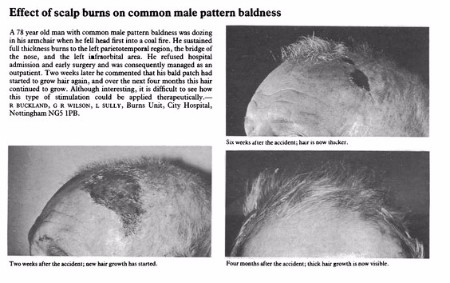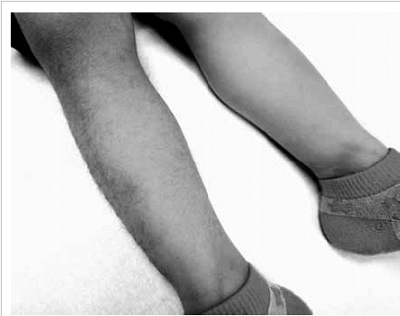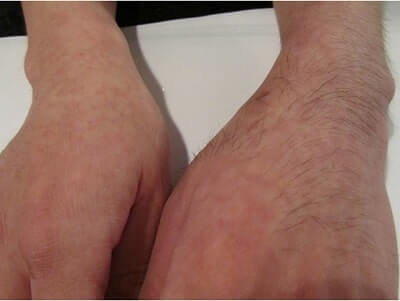Years ago, when I first heard about wounding induced hair growth, I was not entirely surprised. We have read numerous examples of older men re-growing hair (after accidents and injuries) in areas of the scalp that had been bald for decades. My favorite example is of the below 78-year old man who accidentally fell into a fire, burnt his scalp, and got hair growth in return.
“Although interesting, it is difficult to see how this type of stimulation could be applied therapeutically”.

Hair Growth After Cast Removal
My recent update on Follica made me think about the interesting phenomenon of hair growth after cast use. Many people who get arm or leg injuries have to use a plaster cast for several months. Upon removal of the cast, some people report a significant increase in the underlying body hair (i.e., hypertrichosis).
Today, I checked to see if there were any studies that discuss this unusual side effect from cast use. Lo and behold, I found some interesting ones with pretty extraordinary before and after photos. The below one is from a study from China titled: “Acquired Localized Hypertrichosis Induced by Internal Fixation and Plaster Cast Application”. The hands belong to a 15-year old boy who had to get a surgery and use a cast after a fracture.
The hair growth image in the actual study above is clearer, since I had to optimize the below image. The surprising thing is that this person has absolutely no hair at the back of the left hand. i.e., this is not just existing body hair becoming thicker. This is “new” hair growth after 6 weeks of cast use on the injured right hand. Kind of like Follica’s “de novo” hair creation concept. The new hair disappeared 4 months after the cast was removed.

Acquired Localized Hypertrichosis
It is not surprising that prolonged friction and enclosure from a plaster cast could make existing hair grow thicker. However, the creation of new hair is very unexpected. Yet another example below from Hong Kong shows hair growth on the right leg of a 28-month old child. That leg had been in a cast for 6 weeks after a fracture. Note that lack of any body hair on the left leg.

Per the authors of the first study that I discussed above, the acquired localized hypertrichosis (ALH) results from: “chronic irritation, inflammation, friction, and occlusion” by the plaster of Paris cast.
And yet another example from Hong Kong is even more striking. This time on the left forearm (of a 16-year old boy) that had been in a splint. Note again that there is no body hair at all on the right forearm. i.e., this person does not normally have hair on any arm.

If I only found examples of thicker hair growth, I would not have written this post. However, all three examples that I presented above show brand new localized hair growth.
Although this post is not exactly related to wounding, I can’t help but think of the following quote from Follica:
“Following skin disruption, cells that migrate to help healing are forced to make a decision: Should I make epidermis, or should I make a hair?“
Of course none of us would ever be indecisive given such a choice.